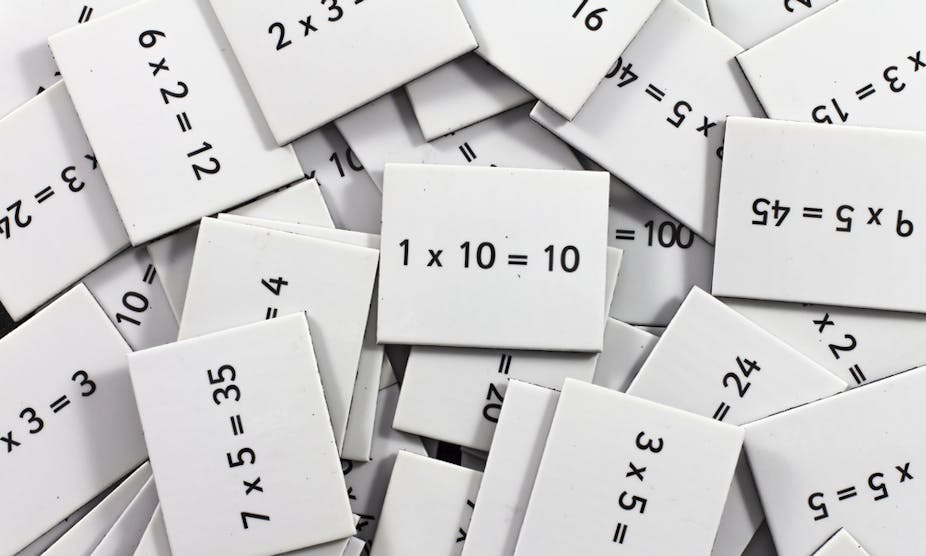Lots of kids have trouble remembering their times tables. Learning them by rote can mean a child can accurately recite the times tables, but has no idea what the numbers actually mean or how to apply this knowledge in a maths problem.
Practice is essential to effective learning, but it is important to keep a balance between practice and application.
Children need to know why they need to learn times tables
The number system underlying the times tables can often seem fairly arbitrary. A child can be forgiven for thinking it’s just a complex system of numbers that they have to learn because the teacher says so.
If you have no idea why you are required to learn something, it is very difficult to develop sufficient motivation to persist with the practice that is often necessary to master the material.
One way to demonstrate the usefulness of the times tables is to engage a child in a counting task. The task could be timed, such that determining the number of elements quickly will mean something for the ultimate result (for example, beating a time limit results in a positive outcome, failing to beat the limit means the task starts again).
The multiplication facts in the times tables can then be demonstrated as short cuts in the counting process (if you can arrange the elements into four groups of eight, then knowing the answer to “4 x 8 = ?” will result in faster performance than having to rely on counting all of the 32 elements).
Many computer games and apps (like IXL Maths) possess this feature. They also involve many other features designed to maintain the interest of a child, which can help keep them motivated enough to persist with the task. Ultimately, the more practice, the better the knowledge.
Get to know the sums individually, not as a song lyric
Memory can often be a good reflection of what we do. If we regularly sing along to a favourite song, each line tends to remind us of the next line. However, if we then try to sing the song by ourselves, without the aid of an accompanying recording, we often find that forgetting one line means subsequent lines also can’t be recalled.
A similar thing can happen if we engage in rote recitation of the times tables. This method is only useful if we want to have a method to fall back upon when all other methods fail. Basically this method can only produce the equivalent of a song lyric where, remembering what “4 8s” are is only possible if you can remember “4 6s are 24” and “4 7s are 28”.
A better form of knowledge is one where a child knows the answer to each multiplication problem as soon as they see it, much like being able to read a word as soon as you see it.
Knowing the answer to each problem is then independent of knowing the answer to other times table problems. This type of knowledge can be gained only by practice at producing the answer.
One method for undertaking this type of practice is something like the old flash-card method. Write a problem on one side of a card (4 x 8 = ?), and the answer on the other side. With a shuffled deck of cards representing all of the problems in the times tables, a child can practise producing the answer to each problem, and then check their response by turning over the card.
Occasionally an adult can ask the child to do this out loud to ensure they are doing the task correctly. Initially the child may have to guess the correct answer, or work it out with their fingers or some other method. But they always have the benefit of immediate feedback by turning over the card.
Eventually, with enough practice, the constant association of the problem with the correct answer will begin to stick in their memory. A similar method can be easily programmed on to a computer or tablet. Plenty of commercial apps are available that will mimic this procedure.
Apply the times tables knowledge
Knowledge of the times tables is not useful by itself. A child must learn to apply the knowledge in a mathematical context.
It is important, though, that a child’s knowledge of the times tables is not allowed to remain as a list of independent facts. A child needs to engage in activities that demonstrate the connections between the multiplication facts in the times tables. It is important to see how 4 x 8 and 8 x 4 are connected.
Ultimately they will also need to see how 4 x 8 = ? and 32 ÷ 8 = ? are connected. To achieve this the child should be provided with activities that require the application of their arithmetic knowledge in a way that can demonstrate and lead the child to uncover these connections.
Practice with this sort of material can help kids develop a knowledge base that results in reliable retrieval of facts and the sort of flexible application of this knowledge that is required in higher-order problems, such as solving for x in 2x + 3 = 11. If you struggle to come up with an answer to this problem, I would not suggest relying on a times tables song to help you out.

